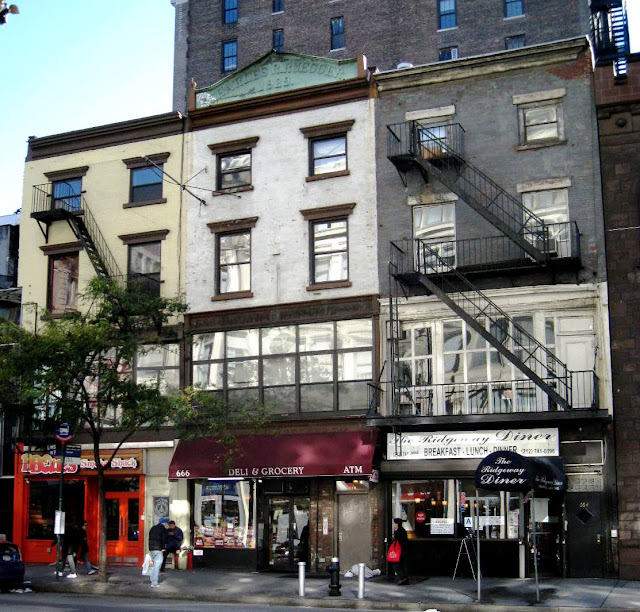 |
| Charles Ruegger took over the middle house in 1929, renovating it as Bazar Francais |
Richard Upjohn’s quaint Church of the Holy Communion had been completed in 1846 at the northeast corner of 20th Street. Four years later William Johnson filled the remainder of the block with five matching four-story brick row houses, including No. 666. Completed In 1851, the modest, vernacular homes were constructed for middle class families.
By the early 1880s 6th Avenue was bustling as commercial buildings began lining the thoroughfare from 14th to 23rd Street. Edwin P. Smith, who owned No. 666 at the time, converted it to small hotel and added an extension to the back. By 1900 the area was known as The Ladies’ Mile and well-dressed female shoppers glided from emporium to emporium along the Avenue. That year the former house was outfitted with a storefront that covered the lower two floors.
C. J. Brodil sold their fancy leather goods here, while another tenant around that time was Hardings Plaiting Establishment. Meanwhile the upper floors were still rented for residential use.
David Harum was living here on October 4, 1905 when he was arrested in a raid on a poolroom. The New York Times noted that he “was bitter at being classed among the goats, and not among the sheep, whom the police turned loose.”
Harum complained to the reporter, “It’s awful to be pinched, but to be called a piker an’ a cheap skate to boot beats all.”
Frazin & Oppenheim established its shoe store here. It was not a good choice of locations, for only a block away, at the southeast corner of 20th Street, was Cammeyer’s, reportedly the largest shoe store in the world. By 1909 Frazin & Oppenheim declared bankruptcy.
Anna M. Wright owned the building in 1911, along with the two former houses on either side. That year it was discovered that a surveying error had resulted in property being omitted from her deed—a strip of land 60 feet long and about ¾ of an inch wide. For the cost of $1.00 the “infinitesimal strip” as a newspaper account described it, was restored to Ms. Wright.
The building was being used as a store and factory in 1925 when Speer Realty Company purchased the property. The wood-framed storefront had been redone in metal in 1922 and a fire escape installed that zigzagged down the façade.
Then in 1929 Chalres R. Ruegger relocated his French kitchen and tableware store here. Ruegger installed an impressive pressed metal parapet above the cornice that boldly announced CHARLES R. RUEGGER 1929. He added another metal sign, BAZAR FRANCAIS, above the second story storefront that ran the width of the building.
 |
| Ruegger added a pressed metal parapet that announced "Charles R. Ruegger 1929." |
 |
| Still visible are the impressed metal signs "Bazar Francais" over the second story window and "Charles R. Ruegger Inc" below it. |
Around this time Ruegger opened a shop nearby on 19th Street for the manufacture industrial metal such as ducts and ventilators. The 78-year old Charles Ruegger died in 1931. He had not only created a successful business in the Bazar Francais but was mayor of Woodridge, New Jersey, for two consecutive terms. His son, Charles Jr., continued running the business.
After World War II the firm would produce its own line of copper and brass cookware. The Bazar Francais continued to offer imported kitchen ware as well as its own high-end goods, becoming the first gourmet outlet in the country. Along with small items like butter brushes, the firm offered decorative and hard-to-find articles like the 1956 nickel-plated wine rack “that completes the apartment dweller’s suburban-scorning life.”
 |
| Bazar Francais manufactured and sold attractive copper and brass goods like this double boiler |
In 1975, after a string of Charles Rueggers had run the Bazar Francais for a century, the business closed.
 |
| A painted sign for Bazar Francais is gradually disappearing on the side wall. Upjohn's Church of the Holy Communion is visible at the right. |
non-credited photographs taken by the author
